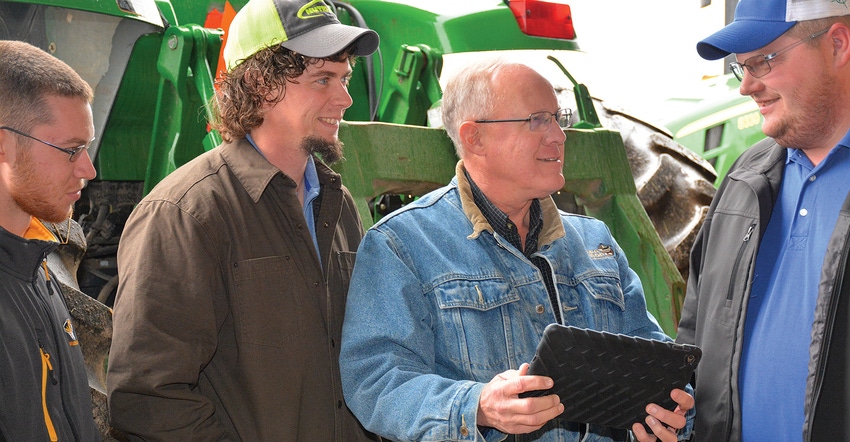
Crop planning is a yearlong process on Lynn Fahrmeier’s farm in north-central Missouri, where his fields are a mix of river bottoms and ridges that require different seed and fertilizer applications, but he is clear on his one objective — plan for profit not yields.
Farmers are finding that past strategies of using high seed counts and the latest hybrids that get the most bushels may not yield the best bottom line. The higher input costs of more seeds, fertilizer and chemicals may negate any income from bigger yields. And with another year of low crop prices, every penny counts.
“Maximizing yield seldom produces the maximum profit,” says Fahrmeier, who spends a good 12 months planning what seeds to plant, where to plant them, and how and when to apply inputs.
Crop budgets are common in that revenue is determined by expected yields, crop prices, ARC payments and crop insurance. Subtract out the costs for seed, fertilizer, chemicals, fuel, equipment, labor, etc., and hopefully, there is a little profit. In 2017, profits will be elusive.
“The big thing is that no matter what you do, it will be hard to see a profit in 2017, although soybeans look better than corn,” says Gary Schnitkey, professor of ag economics at the University of Illinois. “Since we are using a $3.30 price, it will be hard to see a profit for corn.”
Schnitkey designs crop budgets using expected average purchase prices for inputs and expected sale prices for crops in various areas of Illinois. As a guide for farmers, these budgets can be found at the university’s farmdoc website. But be warned, the results are not pretty.
“The big wild card is the price of soybeans,” says Schnitkey.
When he created his budgets late in 2016, new-crop soybeans were over $10 a bushel, which would return a small profit based on average prices for inputs. But he warns those prices may not be there this spring.
“Anybody who has built in a price now has a profit, but what will that price be if farmers add soybean acres? The question of the day is ‘Are farmers going to switch?’ ” he asks.
Schnitkey expects by mid-May some switching of corn acres to soybeans will occur, and to accommodate such a switch, farmers would need to apply nitrogen after planting rather than before.
Fahrmeier agrees on the potential profit for soybeans. He has some of his 2017 crop sold and hopes to sell more during anticipated price bumps this spring. However, regardless what prices do, his 60-40 soybean-to-corn layout is pretty much set.
“I would probably be 50-50 if it wasn’t for these creek bottoms that we farm,” Fahrmeier says. “Because of the flood risk, we stay with the soybeans, because I can get them in later and out sooner.
“If it stays wet for six weeks, we are changing everything, but at least I am changing it from a baseline,” says Fahrmeier. “I am not coming up with a new plan, I am just modifying an existing one.”
Less may be more
Two states to the east in northeast Indiana, Kevin Stoy sits down with his family partners every winter and makes the similar hard decisions over corn and soybean hybrids, seed populations, crop location, and input use. He farms land in three states and deals with a number of landlords, which complicates planting and budgeting decisions.
Sometimes he follows the advice provided by seed and chemical advisers; sometimes he doesn’t. This year Stoy has been veering away from contemporary crop strategies of higher seed counts.
“I remember when being told that planting 26,000 seeds of corn per acre was too much. So why are we being told to plant 32,000 now?” he asks. “We have been so ingrained in agriculture to increase, increase, increase.”
Now, he says increasing seed counts and adding fertilizers may not yield the best bottom-line returns.
“I want to cut, but the voices we hear whispering in our ear say, ‘You can’t cut,’ ”he says. “We have been trained for 20-plus years now that if you don’t buy the latest and greatest corn, you are going to sacrifice bushels.”
That thinking is being applied to fertilizer and chemicals as well, in that applications may be reduced to levels that will not sacrifice the economic return.
The decisions on what to plant and how to manage the crops are still being made, but Stoy says he and his crew are re-evaluating past practices with a focus on what is best in the current price environment.
“We are intensely looking at yield potential and are budgeting for that yield potential on a field-by-field basis,” he says. “This is actually good for agriculture because all of us who survive will know our businesses way better than we knew it before. We will be more efficient.”
Related: Building profits, part one: Start with your marketing plan
Related: Building profits, part two: A 3-step approach to lower costs
About the Author(s)
You May Also Like




